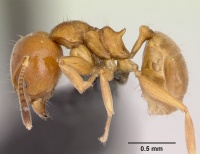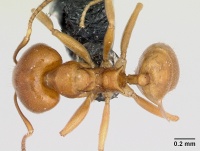Aneuretus
| Aneuretus | |
|---|---|

| |
| Aneuretus simoni | |
| Scientific classification | |
| Kingdom: | Animalia |
| Phylum: | Arthropoda |
| Class: | Insecta |
| Order: | Hymenoptera |
| Family: | Formicidae |
| Subfamily: | Aneuretinae |
| Tribe: | Aneuretini |
| Genus: | Aneuretus Emery, 1893 |
| Type species | |
| Aneuretus simoni | |
| Diversity | |
| 1 species (Species Checklist, Species by Country) | |
Aneuretus simoni is the only species of Aneuretus and is the only extant member of the subfamily Aneuretinae. Long believed to be a basal lineages of Formicidae, molecular phylogenetics have shown the group is closely related to the Dolichoderinae (see the subfamily phylogeny).
| At a Glance | • Monotypic |
Identification
Sting (that may not be visible), single petiole with a long, narrow anterior peduncle, propodeum armed with a pair of spines. Major tibial spur of hind leg simple or with a few minute barbules. Palp forumula 3,4. Only known from Sri Lanka.
In the field workers resemble small yellow Pheidole minors in their morphology. Behaviorally they have a tendency to keep their long petiole folded up against their propodeum with their gaster slightly elevated.
| See images of species within this genus |
Distribution
Endemic to Sri Lanka.
Distribution and Richness based on AntMaps
Species by Region
Number of species within biogeographic regions, along with the total number of species for each region.
| Afrotropical Region | Australasian Region | Indo-Australian Region | Malagasy Region | Nearctic Region | Neotropical Region | Oriental Region | Palaearctic Region | |
|---|---|---|---|---|---|---|---|---|
| Species | 0 | 0 | 0 | 0 | 0 | 0 | 1 | 0 |
| Total Species | 2841 | 1736 | 3045 | 932 | 835 | 4379 | 1741 | 2862 |
Biology
See Aneuretus simoni, the only extant species, for information about the biology of this genus.
Flight Period
All Flight Records for Genus
 Explore: Show all Flight Month data or Search these data. See also a list of all data tables or learn how data is managed.
Explore: Show all Flight Month data or Search these data. See also a list of all data tables or learn how data is managed.
| Taxon | Month | Source | Notes |
|---|---|---|---|
| Aneuretus simoni | Jul • Aug |
Castes
The single extant species of the genus has dimorphic workers.
Morphology
Worker Morphology
 Explore: Show all Worker Morphology data or Search these data. See also a list of all data tables or learn how data is managed.
Explore: Show all Worker Morphology data or Search these data. See also a list of all data tables or learn how data is managed.
• Antennal segment count: 12 • Antennal club: gradual • Palp formula: 3,4 • Total dental count: 9-11 • Spur formula: 1 simple, 1 simple • Eyes: 11-100 ommatidia • Scrobes: absent • Pronotal Spines: absent • Mesonotal Spines: absent • Propodeal Spines: present • Petiolar Spines: absent • Caste: dimorphic • Sting: present • Metaplural Gland: present • Cocoon: present
Nomenclature
The following information is derived from Barry Bolton's Online Catalogue of the Ants of the World.
- ANEURETUS [Aneuretinae]
- Aneuretus Emery, 1893a: cclxxv. Type-species: Aneuretus simoni, by monotypy.
- [Aneuretus also described as new by Emery, 1893f: 241.]
References
- Ashmead, W. H. 1905c. A skeleton of a new arrangement of the families, subfamilies, tribes and genera of the ants, or the superfamily Formicoidea. Can. Entomol. 37: 381-384 (page 384, Aneuretus in Dolichoderinae)
- Barden, P. 2017. Fossil ants (Hymenoptera: Formicidae): ancient diversity and the rise of modern lineages. Myrmecological News 24: 1-30.
- Baroni Urbani, C. 1989. Phylogeny and behavioural evolution in ants, with a discussion of the role of behaviour in evolutionary processes. Ethol. Ecol. Evol. 1: 137-168 (page 147, Aneuretus in Dolichoderinae, Aneuretini)
- Baroni Urbani, C.; Bolton, B.; Ward, P. S. 1992. The internal phylogeny of ants (Hymenoptera: Formicidae). Syst. Entomol. 17: 301-329 (page 315, Aneuretus in Aneuretinae, Aneuretini )
- Bingham, C. T. 1903. The fauna of British India, including Ceylon and Burma. Hymenoptera, Vol. II. Ants and Cuckoo-wasps. London: Taylor and Francis, 506 pp. (page 290, Aneuretus in Dolichoderinae)
- Bolton, B. 1990e. Army ants reassessed: the phylogeny and classification of the doryline section (Hymenoptera, Formicidae). J. Nat. Hist. 2 24: 1339-1364 (page 1361, Aneuretus in Aneuretinae, Aneuretini )
- Bolton, B. 1994. Identification guide to the ant genera of the world. Cambridge, Mass.: Harvard University Press, 222 pp. (page 15, Aneuretus in Aneuretinae, Aneuretini )
- Bolton, B. 2003. Synopsis and Classification of Formicidae. Mem. Am. Entomol. Inst. 71: 370pp (page 80, Aneuretus in Aneuretinae, Aneuretini )
- Boudinot, B.E., Richter, A.K., Hammel, J.U., Szwedo, J., Bojarski, B., Perrichot, V. 2022. Genomic-phenomic reciprocal illumination: Desyopone hereon gen. et sp. nov., an exceptional Aneuretine-like fossil ant from Ethiopian amber (Hymenoptera: Formicidae: Ponerinae). Insects 13(9), 796 (doi:10.3390/insects13090796).
- Brown, W. L., Jr. 1973b. A comparison of the Hylean and Congo-West African rain forest ant faunas. Pp. 161-185 in: Meggers, B. J., Ayensu, E. S., Duckworth, W. D. (eds.) Tropical forest ecosystems in Africa and South America: a comparative review. Wash (page 169, Aneuretus in Dolichoderinae, Aneuretini)
- Burchill, A.T., Moreau, C.S. 2016. Colony size evolution in ants: macroevolutionary trends. Insectes Sociaux 63, 291–298 (doi:10.1007/s00040-016-0465-3).
- Cantone S. 2017. Winged Ants, The Male, Dichotomous key to genera of winged male ants in the World, Behavioral ecology of mating flight (self-published).
- Cantone S. 2018. Winged Ants, The queen. Dichotomous key to genera of winged female ants in the World. The Wings of Ants: morphological and systematic relationships (self-published).
- Chapman, J. W.; Capco, S. R. 1951. Check list of the ants (Hymenoptera: Formicidae) of Asia. Monogr. Inst. Sci. Technol. Manila 1: 1-327 (page 181, Aneuretus in Dolichoderinae, Aneuretini)
- Clark, J. 1951. The Formicidae of Australia. Vol. 1. Subfamily Myrmeciinae. Melbourne: CSIRO, 230 pp. (page 16, Aneuretus in Aneuretinae, Aneuretini (footnote))
- Dlussky, G. M.; Fedoseeva, E. B. 1988. Origin and early stages of evolution in ants. Pp. 70-144 in: Ponomarenko, A. G. (ed.) Cretaceous biocenotic crisis and insect evolution. Moskva: Nauka, 232 pp. (page 78, Aneuretus in Aneuretinae, Aneuretini )
- Donisthorpe, H. 1943g. A list of the type-species of the genera and subgenera of the Formicidae. [part]. Ann. Mag. Nat. Hist. 11(10): 617-688 (page 623, Aneuretus in Dolichoderinae, Aneuretini)
- Emery, C. 1893a [1892]. [Untitled. Introduced by: "M. C. Emery, de Bologne, envoie les diagnoses de cinq nouveaux genres de Formicides".]. Bull. Bimens. Soc. Entomol. Fr. 1892:cclxxv-cclxxvii. (page cclxxv, Aneuretus as genus)
- Emery, C. 1893h. Voyage de M. E. Simon à l'île de Ceylan (janvier-février 1892). Formicides. Ann. Soc. Entomol. Fr. 62: 239-258 (page 241, Aneuretus also described as new)
- Emery, C. 1895l. Die Gattung Dorylus Fab. und die systematische Eintheilung der Formiciden. Zool. Jahrb. Abt. Syst. Geogr. Biol. Tiere 8: 685-778 (page 767, Aneuretus in Ponerinae)
- Emery, C. 1896e. Clef analytique des genres de la famille des Formicides, pour la détermination des neutres. Ann. Soc. Entomol. Belg. 40: 172-189 (page 175, Aneuretus in Ponerinae)
- Emery, C. 1913a [1912]. Hymenoptera. Fam. Formicidae. Subfam. Dolichoderinae. Genera Insectorum 137: 1-50 (page 6, Aneuretus in Dolichoderinae, Aneuretini)
- Fernandez, F., Guerrero, R.J., Sánchez-Restrepo, A.F. 2021. Sistemática y diversidad de las hormigas neotropicales. Revista Colombiana de Entomología 47, 1–20 (doi:10.25100/socolen.v47i1.11082).
- Forel, A. 1895f. Les Formicides de l'Empire des Indes et de Ceylan. Part V. J. Bombay Nat. Hist. Soc. 9: 453-472 (page 461, Aneuretus in Dolichoderinae)
- Forel, A. 1917. Cadre synoptique actuel de la faune universelle des fourmis. Bull. Soc. Vaudoise Sci. Nat. 51: 229-253 (page 247, Aneuretus in Dolichoderinae, Aneuretini)
- Hölldobler, B.; Wilson, E. O. 1990. The ants. Cambridge, Mass.: Harvard University Press, xii + 732 pp. (page 16, Aneuretus in Aneuretinae, Aneuretini )
- Jayasuriya, A. K. and J. F. A. Traniello. 1986. The biology of the primitive ant Aneuretus simoni (Emery) (Formicidae: Aneuretinae). I. Distribution, abundance, colony structure, and foraging ecology. Insectes Sociaux. 32:363-374.
- Shattuck, S. O. 1992b. Higher classification of the ant subfamilies Aneuretinae, Dolichoderinae and Formicinae (Hymenoptera: Formicidae). Syst. Entomol. 17: 199-206 (page 201, Aneuretus in Aneuretinae, Aneuretini )
- Shattuck, S. O. 1994. Taxonomic catalog of the ant subfamilies Aneuretinae and Dolichoderinae (Hymenoptera: Formicidae). Univ. Calif. Publ. Entomol. 112:i-xix, 1-241. (page 1, Aneuretus in Aneuretinae, Aneuretini )
- Snelling, R. R. 1981. Systematics of social Hymenoptera. Pp. 369-453 in: Hermann, H. R. (ed.) Social insects. Volume 2. New York: Academic Press, xiii + 491 pp. (page 400, Aneuretus in Aneuretinae, Aneuretini )
- Wheeler, W. M. 1910b. Ants: their structure, development and behavior. New York: Columbia University Press, xxv + 663 pp. (page 142, Aneuretus in Dolichoderinae)
- Wheeler, W. M. 1922i. Ants of the American Museum Congo expedition. A contribution to the myrmecology of Africa. VII. Keys to the genera and subgenera of ants. Bull. Am. Mus. Nat. Hist. 45: 631-710 (page 688, Aneuretus in Dolichoderinae, Aneuretini)
- Wilson, E. O.; Eisner, T.; Wheeler, G. C.; Wheeler, J. 1956. Aneuretus simoni Emery, a major link in ant evolution. Bulletin of the Museum of Comparative Zoology 115: 81-99 (page 81, Review of genus; page 93, Aneuretus in Aneuretinae, Aneuretini )

